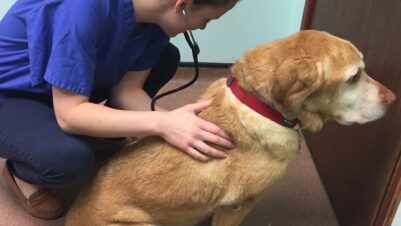Fear responses to loud noises is a common behaviour problem in dogs yet it largely goes undiagnosed. Owners do not realise that the condition can be treated, so do not seek professional help until days before bonfire night when there is a steady stream of clients wanting medication for their dog. Cats tend to be under-represented, probably because they deal with stress in a different way, so owners do not recognise the signs. Yet, they too can be affected by sound sensitivities which can impact on their welfare.
Veterinary staff are well placed to provide useful advice during the firework season. They can encourage owners to follow treatment plans to enhance animal welfare and minimise fear and anxiety in their pets at this time of the year.
Managing the environment
Create a safe haven well ahead of the event
This should be in a place that the pet usually retreats to at times of distress. Commonly this is under a piece of furniture but an open crate may be used. Taking cover in a bolt-hole is a coping strategy so advise owners against pulling them out. Enhance the area by draping a heavy blanket over the sides to deaden the sound and provide blankets and towels for digging and hiding under. Setting up food trails, scent and find games and activity feeders will provide mental enrichment and positive associations with the den.
As well as hiding, some cats cope by using 3D space. Cat trees with integrated retreats and upturned cardboard boxes with entrance cut-outs can provide safety zones.
Pheromone therapy
Dog-appeasing pheromone is associated with increased safety and security. Research shows that using Adaptil Calm (Ceva) in the location of a hide increases its use. Owners should therefore be advised to use it during training and throughout the firework season. Similarly, Feliway Classic (Ceva), the feline facial pheromone (F3 fraction), has been shown to help cats cope during a challenging event and increases security in the home. These products are very much part of a plan to help a pet cope better but they are unlikely to provide a cure when used alone.
Human-animal interactions
Whilst stress often results in escape and hiding behaviours, some dogs will seek the company of their owner. Advice to “ignore them”, because of the potential for reinforcing fearful behaviours, is more likely to cause greater distress. Emotions cannot be reinforced so providing some reassurance may help relieve stress. Once the firework season has passed, work should begin on behaviour modification to encourage better coping strategies in the long term.
Loud, low frequency sounds are difficult for cats to localise so they tend to show behaviour inhibition by hiding and keeping very still until the threat passes. Cats picked up at this time can exhibit a panic response and inflict serious injuries. Owners should be advised against such action.
Medication
Dexmedetomidine oromucosal gel (Sileo by Zoetis) is currently the only product approved by the European Medicines Agency and Food and Drug Administration for treating canine noise aversion. However, it has no amnesic properties and is required to be given between the gum and cheek, making it difficult for some clients to administer. As such, advice should be provided.
Acepromazine (ACP) was traditionally the drug of choice and some owners still ask for “the little yellow pill”, but this drug has disadvantages. It blocks motor responses yet sensory perception is left intact, can lead to behavioural disinhibition and increases sound sensitivity.
Evidence is limited on the efficacy of nutraceuticals and other non-conventional products so it is important that the veterinary team are knowledgeable about recommendations made. Nevertheless, some may have a place as part of a balanced approach. For example, alphacasozepine (Zylkene by Vetoquinol) has been shown to reduce anxiety in cats and Adaptil Express tablets (Ceva) were shown to rapidly decrease signs of fear in dogs scared by fireworks.
Long-term help
The veterinary team should be proactive in following up cases when the event is over to ensure that the long-term problem is addressed. Desensitisation and counter-conditioning over an extended time period, although time consuming, has an excellent prognosis with the right treatment regime. Owners must be directed to a suitably qualified behaviourist or a member of the team with knowledge and a special interest in behaviour.
DogsTrust has teamed up with vets Sarah Heath and Jon Bowen to provide Sounds Scary – sound effects to help with behavioural treatment programmes –available free of charge: https://www.dogstrust.org.uk/help-advice/dog-behaviour-health/sound-therapy-for-pets







